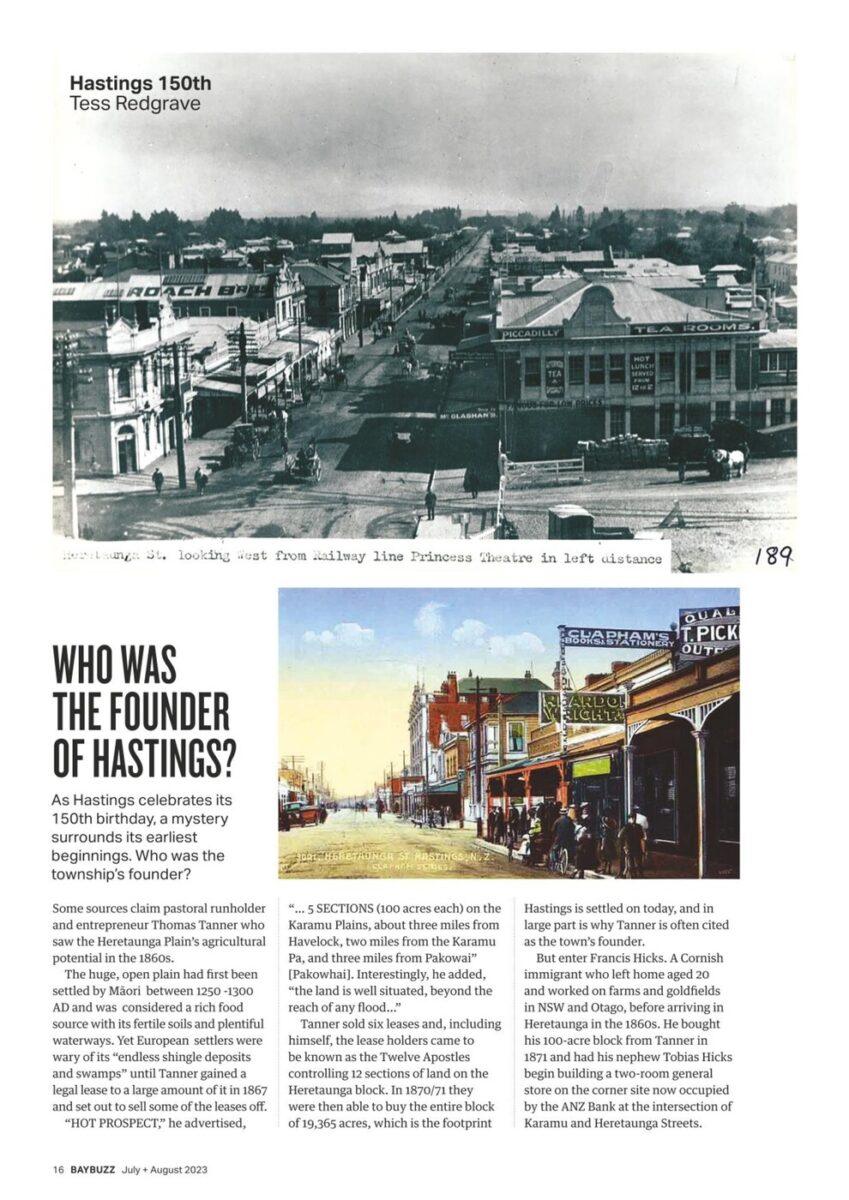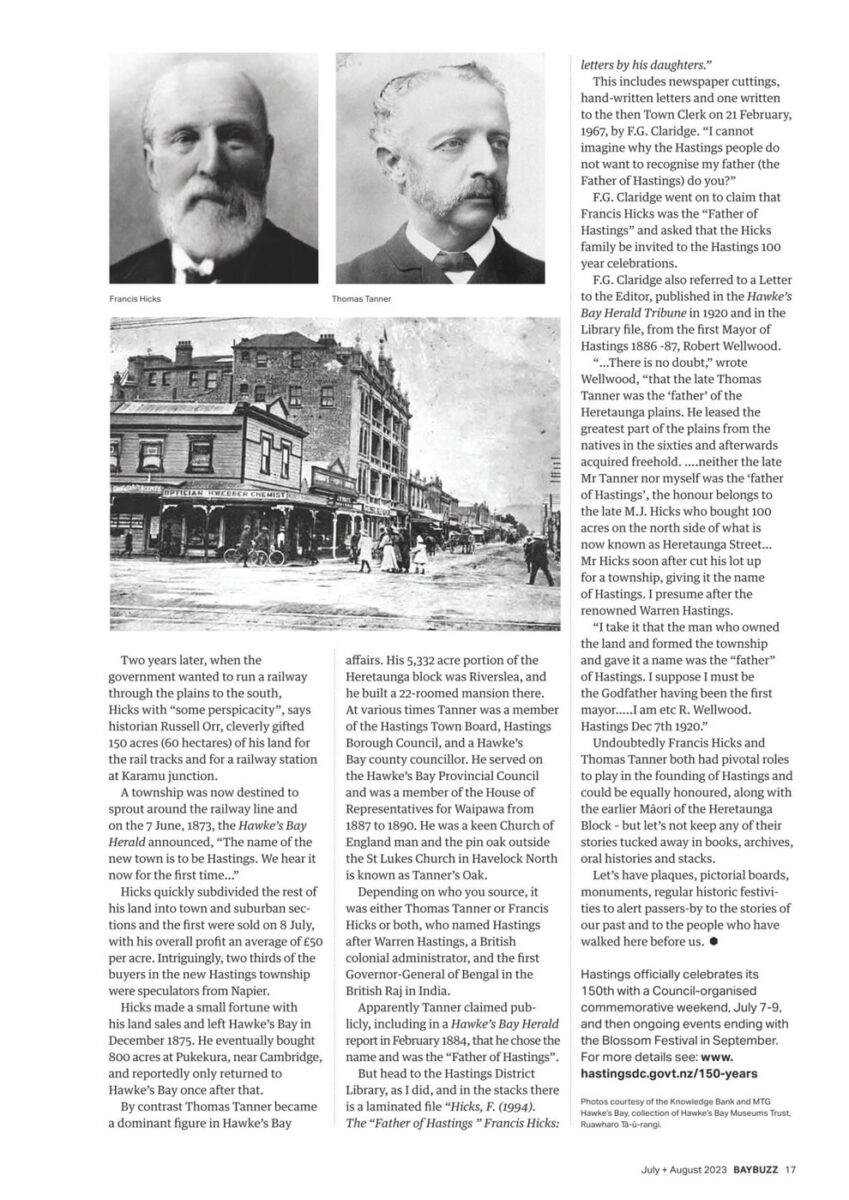Two years later, when the government wanted to run a railway through the plains to the south, Hicks with “some perspicacity”, says historian Russell Orr, cleverly gifted 150 acres (60 hectares) of his land for the rail tracks and for a railway station at Karamu junction.
A township was now destined to sprout around the railway line and on the 7 June, 1873, the Hawke’s Bay Herald announced, “The name of the new town is to be Hastings. We hear it now for the first time …”
Hicks quickly subdivided the rest of his land into town and suburban sections and the first were sold on 8 July, with his overall profit an average of £50 per acre. Intriguingly two thirds of the buyers in the new Hastings township were speculators from Napier.
Hicks made a small fortune with his land sales and left Hawke’s Bay in December 1875. He eventually bought 800 acres at Pukekura, near Cambridge, and reportedly only returned to Hawke’s Bay once that that.
By contrast Thomas Tanner became a dominant figure in Hawke’s Bay affairs. His 5,332 acre portion of the Heretaunga block was Riverslea, and he built a 22-roomed mansion there. At various times Tanner was a member of the Hastings Town Board, Hastings Borough Council, and a Hawke’s Bay county councillor. He served on the Hawke’s Bay Provincial Council and was a member of the House of Representatives for Waipawa from 1887 to 1890. He was a keen Church of England man and the pin oak outside the St Lukes Church in Havelock North is known as Tanner’s Oak.
Depending on who you source, it was either Thomas Tanner or Francis Hicks or both, who named Hastings after Warren Hastings, a British colonial administrator, and the first Governor-General of Bengal in the British Raj in India.
Apparently Tanner claimed publicly, including in a Hawke’s Bay Herald report in February 1884, that he chose the name and was the “Father of Hastings”.
But head to the Hastings District Library, as I did, and in the stacks there is a laminated file “Hicks, F. (1994). The Father of Hastings” Francis Hicks: letters by his daughters.”
This includes newspaper cuttings, hand-written letters and one written to the then Town Clerk on 21 February, 1967, by F.G. Claridge. “I cannot imagine why the Hastings people do not want to recognise my father (the Father of Hastings) do you?”
F.G. Claridge went on to claim that Francis Hicks was the “Father of Hastings” and asked that the Hicks family be invited to the Hastings 100 year celebrations.
F.G. Claridge also referred to a Letter to the Editor, published in the Hawke’s Bay Herald Tribune in 1920 and in the Library file, from the first Major of Hastings 1886-87, Robert Wellwood.
“…There is no doubt,” wrote Wellwood, “that the late Thomas Tanner was the ‘father’ of the Heretaunga plains. He leased the greatest part of the plains from the natives in the sixties and afterwards acquired freehold. …neither the late Mr Tanner nor myself was the ‘father of Hastings’, the honour belongs to the late M.J. Hicks who bought 100 acres on the north side of what is now known as Heretaunga Street … Mr Hicks soon after cut his lot up for a township, giving it the name of Hastings. I presume after the renowned Warren Hastings.
“I take it that the man who owned the land and formed the township and gave it a name was the “father” of Hastings. I suppose I must be the Godfather having been the first mayor … I am etc R. Wellwood. Hastings Dec 7th 1920.”
Undoubtedly Francis Hicks and Thomas Tanner both had pivotal roles to play in the founding of Hastings and could be equally honoured, along with the earlier Maori of the Heretaunga Block but let’s not keep any of their stories tucked away in books, archives, oral histories and stacks.
Let’s have plaques, pictorial boards, monuments, regular historic festivals to alert passers-by to the stores of our past and to the people who have walked here before us.
Hastings officially celebrates its 150th with a Council-organised commemorative weekend, July 7-9, and then ongoing events ending with the Blossom Festival in September.
For more details see: [www].hastingsdc.govt.nz/150-years
Photos courtesy of the Knowledge Bank and MTG Hawke’s Bay, collection of Hawke’s Bay Museums Trust, Rauwharo Ta-u-rangi.
Photo captions –
Francis Hicks
Thomas Tanner













Do you know something about this record?
Please note we cannot verify the accuracy of any information posted by the community.